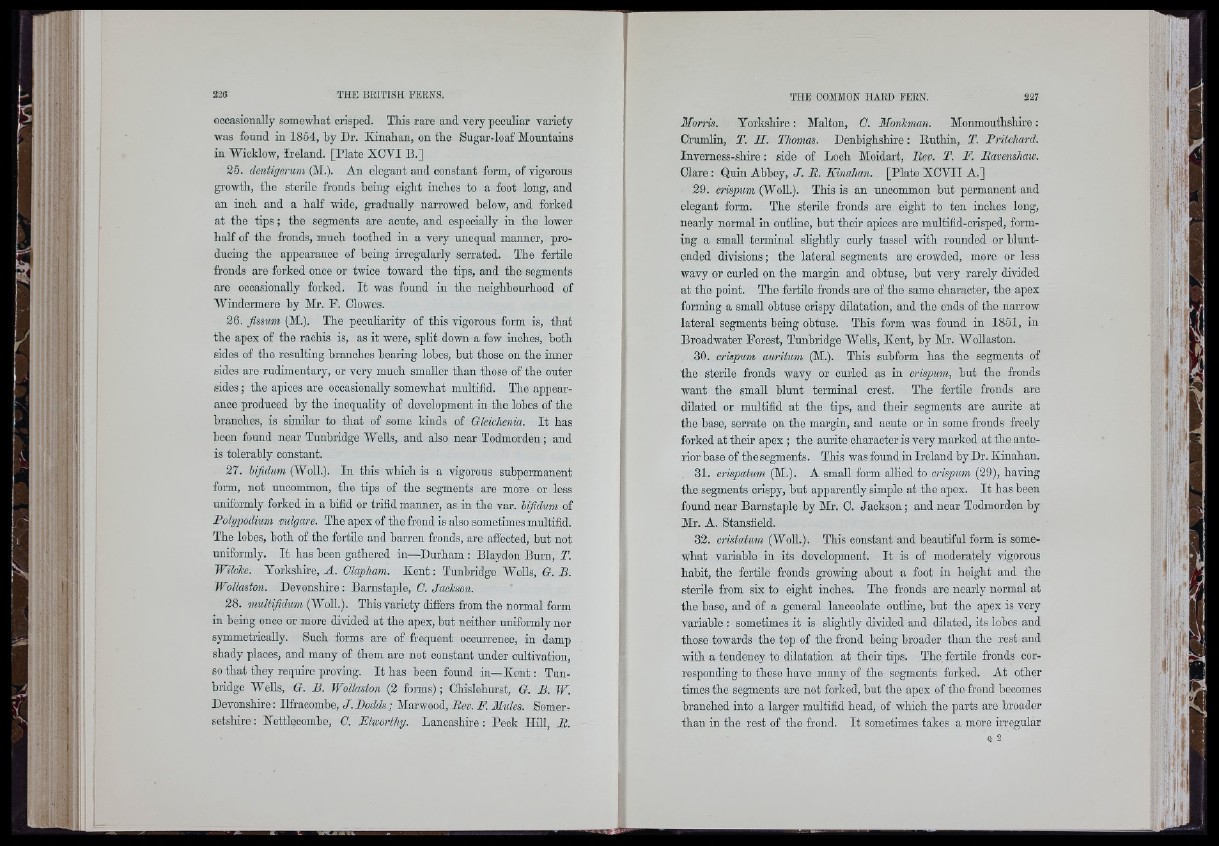
i l l ;
í
tii ?>
;/|
! Í
¡til
1 tifii.
I i-lr i
' 'tí.V
¡ t i
' 1
.1•s.;'
,1
, i
r;
(¡lü l;
d :
,4:
' 5 5
A
m
i ' i
k-:i5 i
226 TH E BKITISH FEKNS.
occasionally somewhat crisped. This rare and very peculiar variety
was found in 1854, by Dr. Kinahan, on the Sugar-loaf Mountains
in Wicklow, Ireland. [Plate XCVI B.]
25. dcntigerum (M.). An elegant and constant form, of vigorous
growth, tho sterile fronds being eight inches to a foot long, and
an inch and a half wide, gradually narrowed helow, and forked
at the tips; tho segments are acute, and especially in the lower
half of the fronds, much toothed iu a very unequal manner, producing
the appearance of being irregularly serrated. The fertile
fronds aro forked once or twice toward the tips, and the segments
aro occasionally forked. It was found in the neighbourhood of
Windermere by Mr. F. Clowes.
26. fismm (M.). The peculiarity of this vigorous form is, that
the apex of the rachis is, as it were, split down a few inches, both
sides of tho resulting branches bearing lobes, hut those on the inner
sides are rudimentary, or very much smaller than those of the outer
sides; the apices are occasionally somewhat multifid. Tho appearance
produced by the inequality of development in the lobos of the
branches, is similar to that of some kinds of Oleiclienia. It has
been found near Tunbridge Wells, and also near Todmorden; and
is tolerably constant.
27. bifidum (Woll.). In this which is a vigorous suhpermanont
form, not uncommon, the tips of the segments aro more or less
uniformly forked in a bifid or trifid maimer, as in the var. bifidum of
Polypodium vulgare. Tho apex of the frond is also sometimes multifid.
The lobes, both of tho fertile and barren fronds, are affootod, but not
uniformly. It has been gathered in—Durham : Blaydon Burn, T.
Wilcke. Yorkshire, A . Clapham. Kent: Tunbridge Wells, Q. B.
Wollaston. Devonshire: Barnstaple, C. Jackson.
28. multifidum (Wo)!.). This variety differs from the normal form
in being once or more divided at tbe apex, but neither uniformly nor
symmetrically. Such forms aro of frequent occurrence, in damp
shady places, and many of them aro not constant under cultivation,
so that they require proving. It has been found in—Kent; Tunbridge
Wells, Q. B. Wollaston (2 forms) ; Chislehurst, G. B. W.
Devonshire: Ilfraoombe, J. Bodds; Marwood, Rev. F. Mules. Somersetshire
: Nettlecombe, C. Flworthy. Lancasliii-e: Peck Hill, R.
TH E COMMON HAED FEEN. 227
Yorkshire: Malton, C. Monkman. Monmouthshire:
CrumHn, T. II. Thomas. Denbighshire: EutHn, T. Pritehard.
Inverness-shire: side of Loch Moidart, Rev. T. F. Ravenshaw.
Clare: Quin Abbey, J. R. Kinahan. [Plato XCYII A.]
29. crispum (WoU.). This is an uncommon but permanent and
elegant form. The sterile fronds are eight to ten inches long,
nearly normal in outUne, hut their apices are multifid-orisped, forming
a smaU terminal sUghtly curly tassel with rounded or blunt-
cnded divisions; the lateral segments are crowded, more or less
wavy or curled on the margin and obtuse, hut very rarely divided
at the point. The fertile fronds are of the same character, the apex
forming a smaU obtuse crispy dilatation, and the ends of the narrow
lateral segments being obtuse. This form was found in 1851, in
Broadwater Forest, Tunbridge WeUs, Kent, by Mr. WoUaston.
30. crispum auritum (M.). This subform has the segments of
the sterile fronds wavy or curled as in crispum, but tho fronds
want the small blunt terminal crest. The fertile fronds aro
dilated or multifid at the tips, and their segments aro anrite at
the base, serrate on tho margin, and acute or in some fronds freely
forked at thoir apex ; the anrite character is very marked at the anterior
base of the segments. This was found in Ireland by Dr. Kinaban.
31. crispatum (M.). A small form allied to crispum (29), having
the segments crispy, hut apparently simple at the apex. It has boon
found near Barnstaple by Mr. C. Jackson; and near Todmorden by
Mr. A. Stansfield.
32. cristatum (Woll.). This constant and beautiful form is somewhat
variable in its development. It is of moderately vigorous
habit, the fertile fronds growmg about a foot in height and the
sterile from six to eight inches. The fronds are nearly normal at
the base, and of a general lanceolate outline, bnt tbo apex is very
variable : sometimes it is slightly divided and dilated, its lobes and
those towards tho top of tho frond heing broader than the rest and
with a tendency to dilatation at their tips. The fertile fronds corresponding
to these have many of tho segments forked. At other
times tho segments are not forked, but the apex of the frond becomes
hranohed into a larger multifid head, of which the parts are broader
than in the rest of the frond. It sometimes takes a more irregular
I J
I"
xWl
; : [(Ifi
;ii'
t 1
I,'-."
■ih'i
/till
■ liH